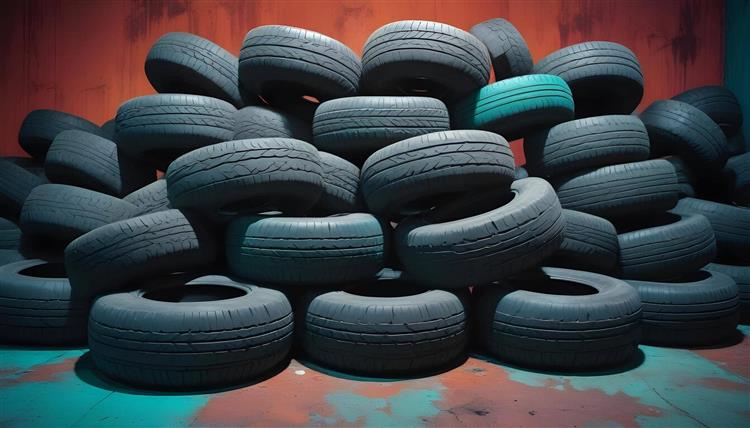
- 11 September 2024
- 1639 Views
Styrene-Butadiene Rubber (SBR) is one of the most widely used synthetic rubbers in tire manufacturing due to its excellent balance of properties such as abrasion resistance, aging stability, and overall performance. As a crucial component in many tire types, SBR helps enhance the durability and safety of vehicles by providing improved grip and wear resistance, making it an indispensable material in the automotive industry.
Understanding Styrene-Butadiene Rubber (SBR)
Styrene-Butadiene Rubber (SBR) is a synthetic rubber derived from the copolymerization of styrene and butadiene. This process combines these monomers into a long-chain polymer that possesses the desirable properties of both constituents: the strength and resilience of butadiene and the processing ease and toughness of styrene. SBR’s flexibility and resistance to cracking make it particularly suitable for high-stress applications like tire treads, where these characteristics contribute to longer tire life and better road performance.
Role of Styrene-Butadiene Rubber (SBR) in Tire Components
SBR is prominently used in various tire components, most notably in the tread and sidewalls:
- Tread: The tread is the part of the tire that makes direct contact with the road. SBR’s high abrasion resistance ensures the tread wears slowly, providing a longer lifespan and better traction under different driving conditions.
- Sidewalls: SBR is also used in the sidewalls of tires to provide additional strength and flexibility. This helps in protecting the tire from impacts and abrasions from curbs and potholes.
In both these applications, SBR helps balance performance and cost, making it a preferred choice for manufacturers aiming to produce high-quality tires that meet stringent safety and performance standards.
Benefits of Styrene-Butadiene Rubber (SBR) in Tires
The use of SBR in tires offers several significant benefits:
Abrasion Resistance: SBR provides excellent abrasion resistance, which is crucial for maintaining the integrity of the tire tread over time. This resistance helps extend the tire's lifespan, reducing the frequency of replacements.
Enhanced Grip and Safety: SBR enhances the grip of tires on wet and dry surfaces, contributing to better handling and safety. This is especially important in passenger car tires where reliable traction is essential for avoiding accidents.
Cost Efficiency: Compared to natural rubber, SBR is more cost-effective to produce, which helps keep manufacturing costs down. This economic advantage allows tire manufacturers to offer quality products at competitive prices.
Versatility: SBR can be tailored to meet specific requirements by adjusting the styrene-to-butadiene ratio, allowing manufacturers to optimize tires for different applications, from high-performance sports tires to everyday commuter tires.
Environmental Impact of Styrene-Butadiene Rubber (SBR) in Tires
While SBR offers many advantages in tire manufacturing, it also poses environmental challenges:
Tire Wear Particles: As tires wear down, they release tiny particles known as tire wear particles (TWPs) into the environment. These particles, primarily composed of SBR, are classified as microplastics and can contribute to pollution in waterways and soil.
Recycling Challenges: The complex composition of SBR tires makes recycling difficult, leading to large numbers of used tires accumulating in landfills. This has prompted ongoing research into more sustainable recycling methods and the development of alternative materials with reduced environmental footprints.
Efforts are underway to improve the sustainability of SBR through innovations in recycling processes and the exploration of bio-based alternatives that offer similar performance with less environmental impact.
Advancements in Styrene-Butadiene Rubber (SBR) for Tires
Recent advancements in SBR technology aim to enhance the material’s performance and environmental sustainability:
Enhanced Formulations: New formulations of SBR are being developed to improve wear resistance and fuel efficiency, which can reduce the overall environmental impact of tires by decreasing rolling resistance and thus fuel consumption.
Sustainable Alternatives: Researchers are exploring bio-based sources for producing SBR to reduce reliance on petroleum-derived materials. These alternatives could provide similar performance characteristics while reducing the carbon footprint of tire manufacturing.
Common Questions About Styrene-Butadiene Rubber (SBR) in Tires
Q: Is Styrene-Butadiene Rubber (SBR) used in all tires?
Yes, SBR is widely used in many types of tires, particularly in passenger car tires, truck tires, and even some specialty tires. Its versatility and cost-effectiveness make it a popular choice across the industry.
Q: How does SBR affect tire performance?
SBR enhances tire performance by providing improved grip, wear resistance, and flexibility. It is especially beneficial in applications that demand high durability and safety.
Q: Are there environmental concerns associated with SBR?
While SBR offers significant performance benefits, its use does contribute to environmental challenges such as microplastic pollution from tire wear particles. Efforts are being made to address these concerns through improved recycling methods and the development of more sustainable alternatives.
Call to Action
If you're interested in learning more about the latest advancements in tire materials or looking for high-quality tires that incorporate cutting-edge SBR technology, explore our detailed SBR product page on Elsapa Alzahbi. Stay informed and choose the best options for your vehicle to ensure optimal performance and safety on the road.
in Conclusion: Styrene-Butadiene Rubber (SBR) plays a vital role in tire manufacturing, providing essential properties that enhance the performance, safety, and longevity of tires. While there are environmental challenges associated with SBR, ongoing research and technological advancements are helping to mitigate these issues and pave the way for more sustainable tire solutions.
